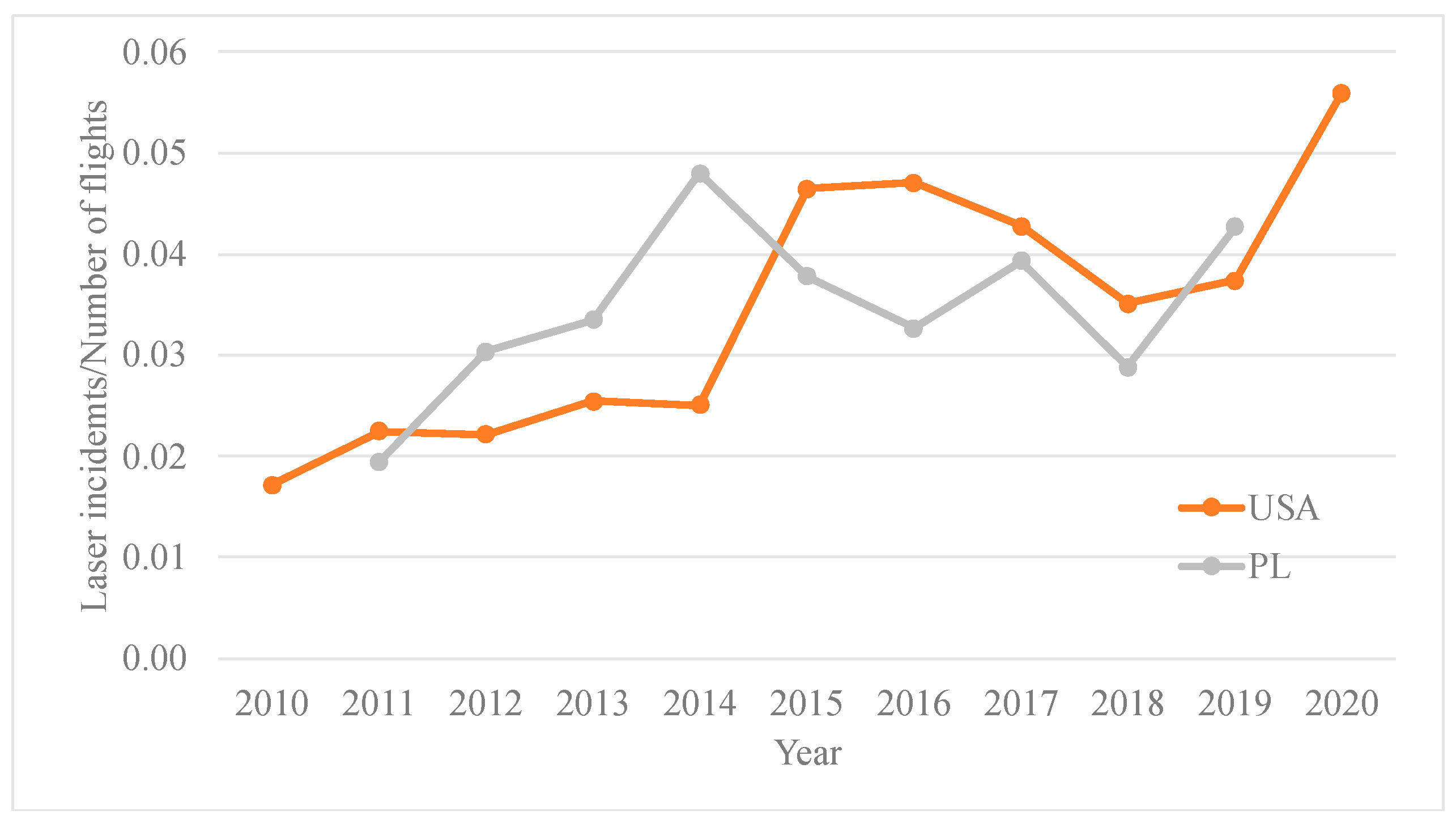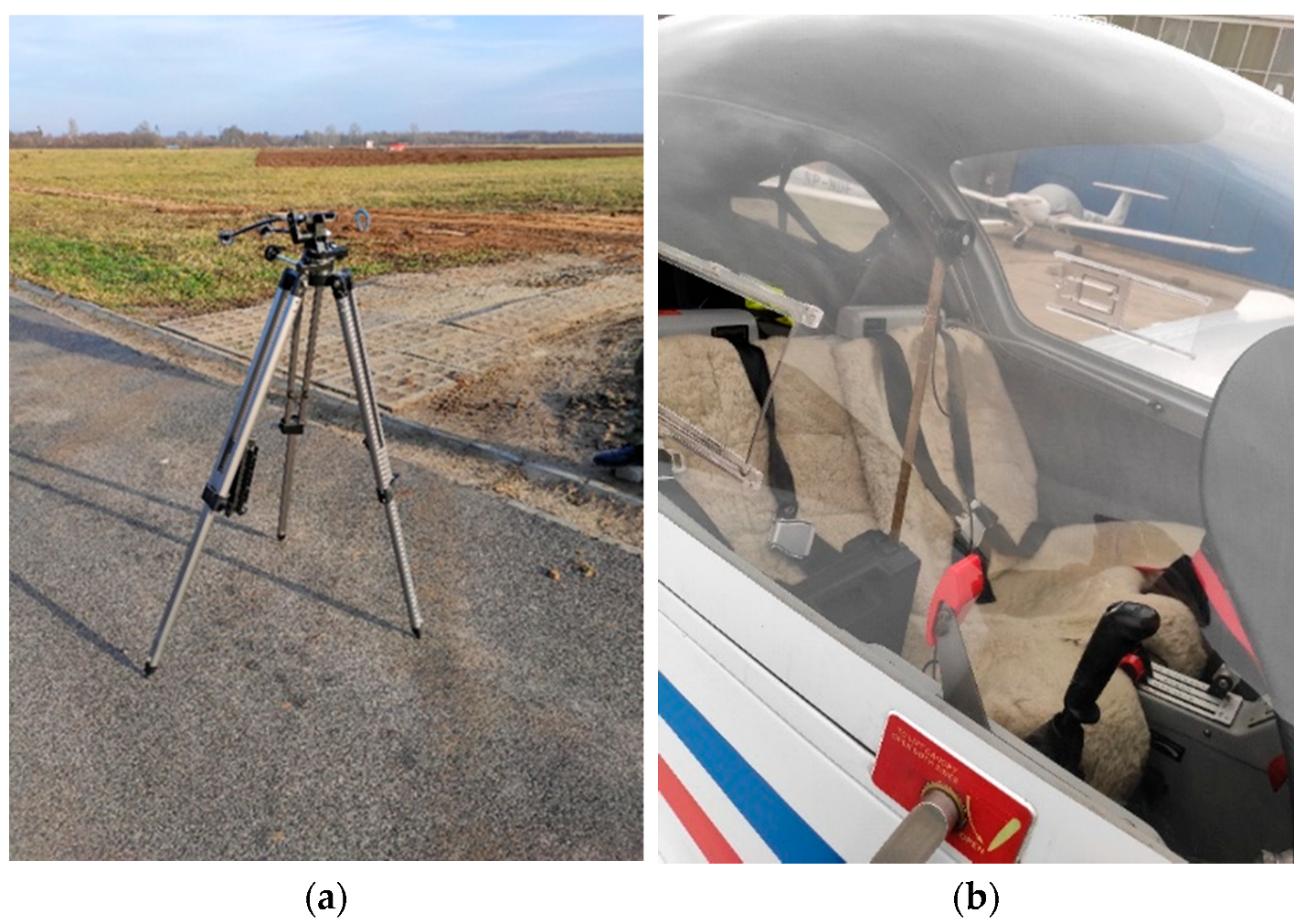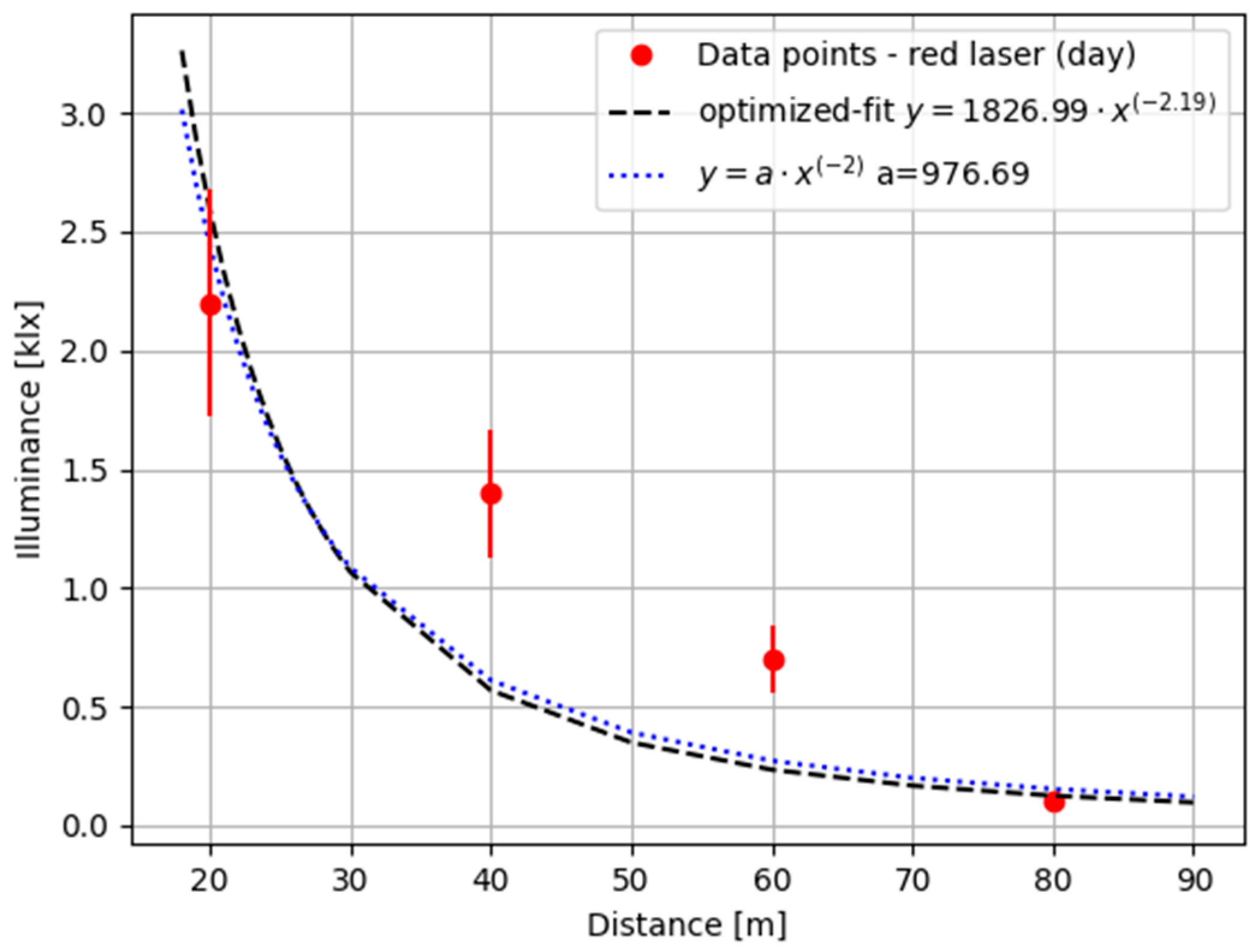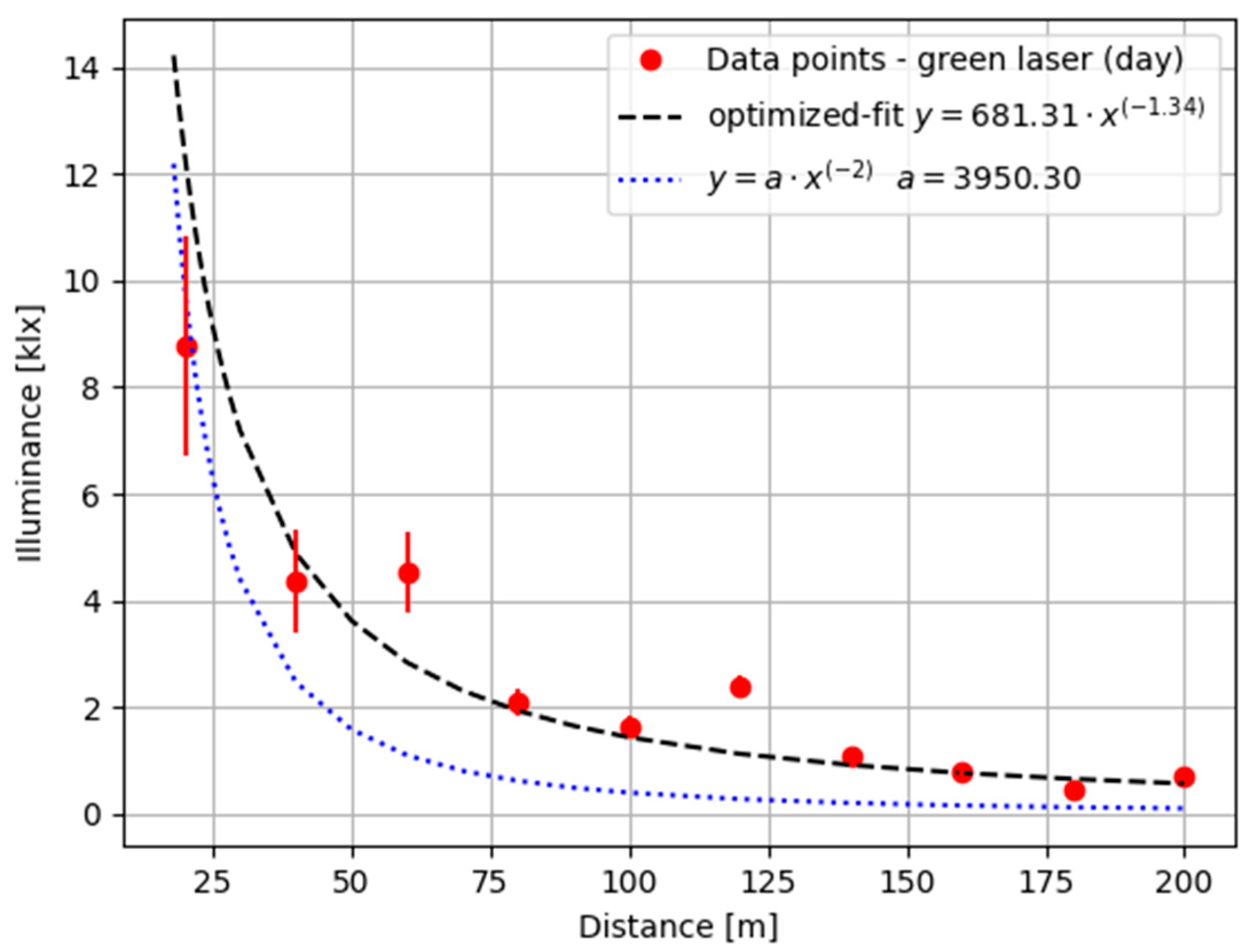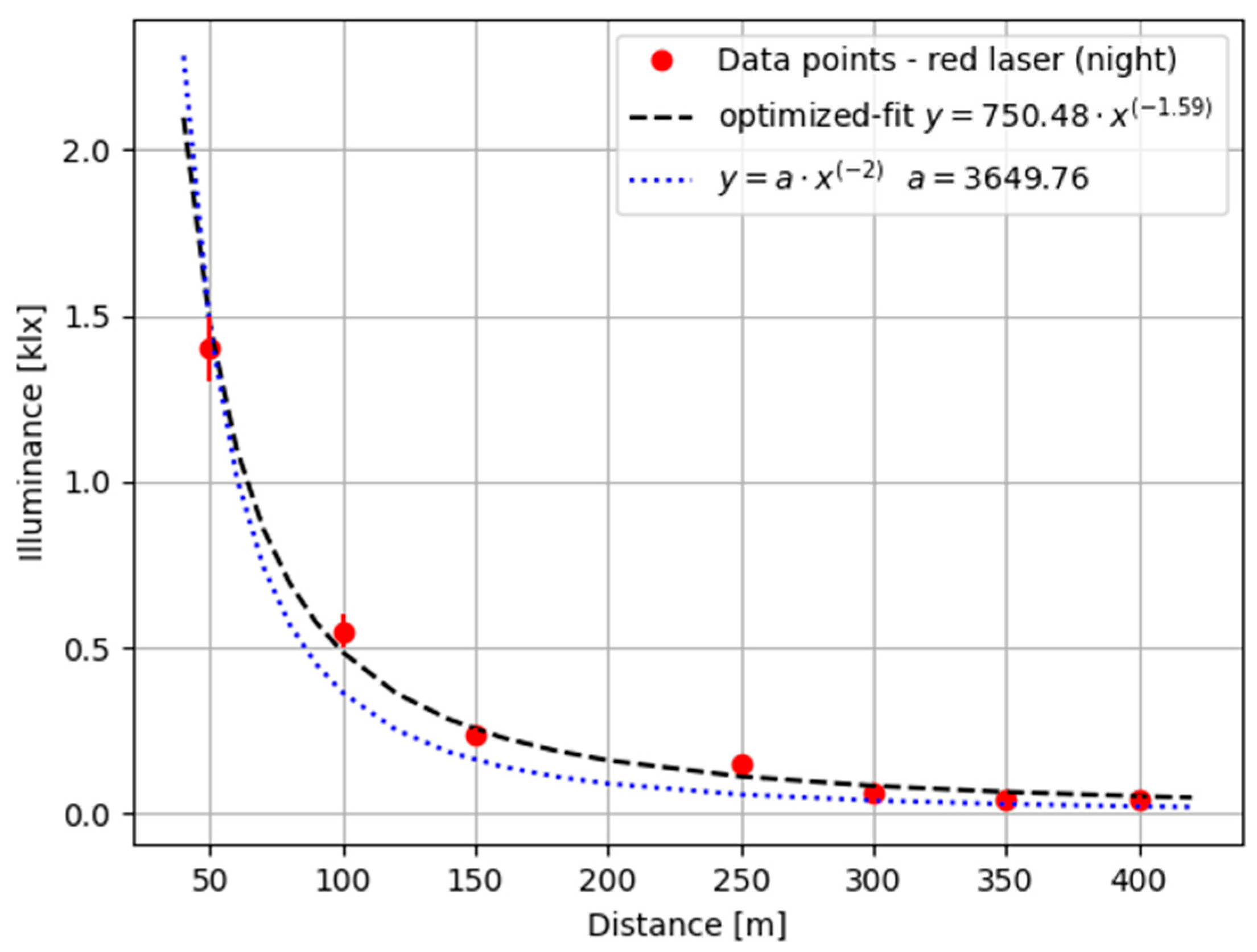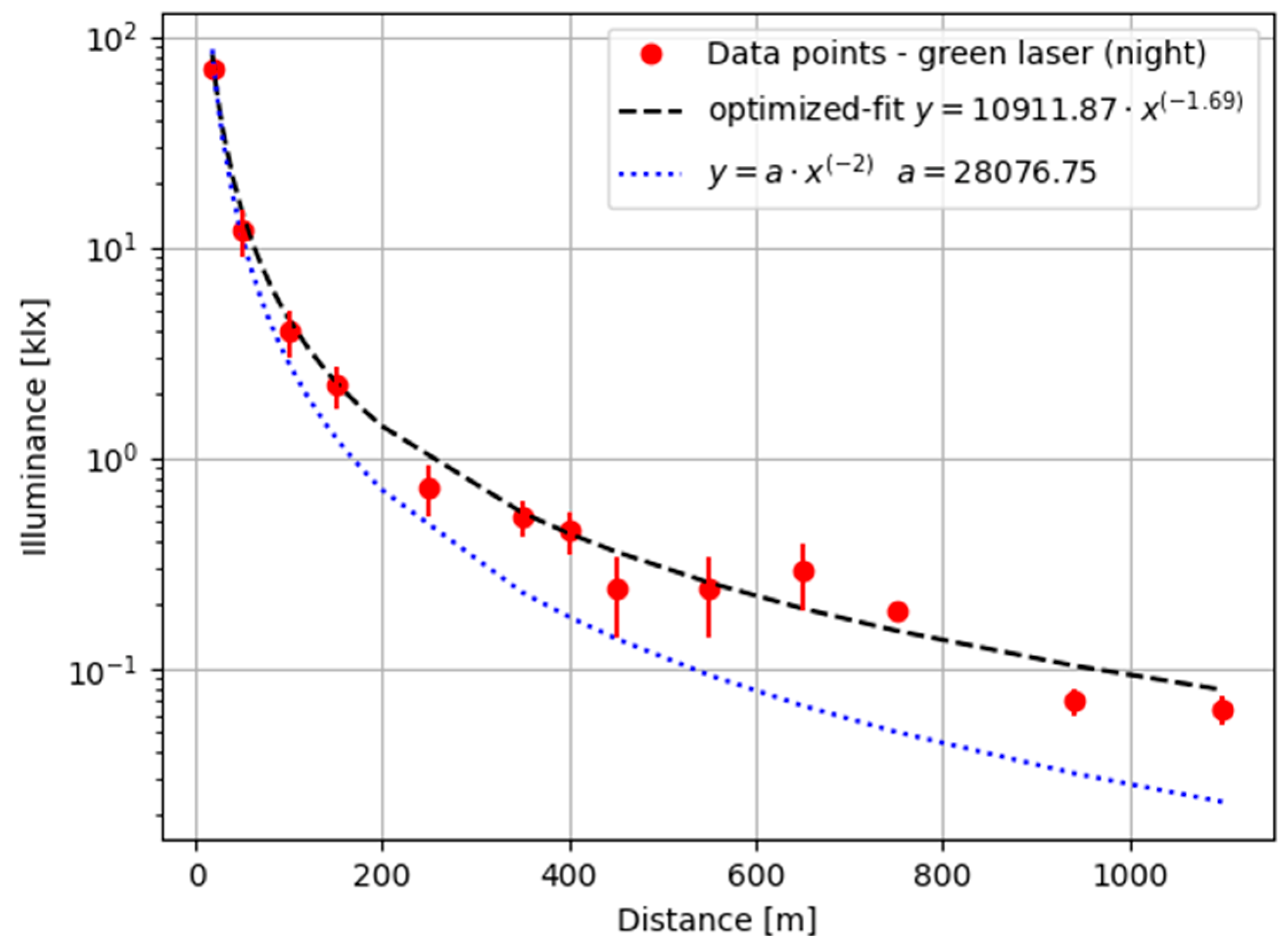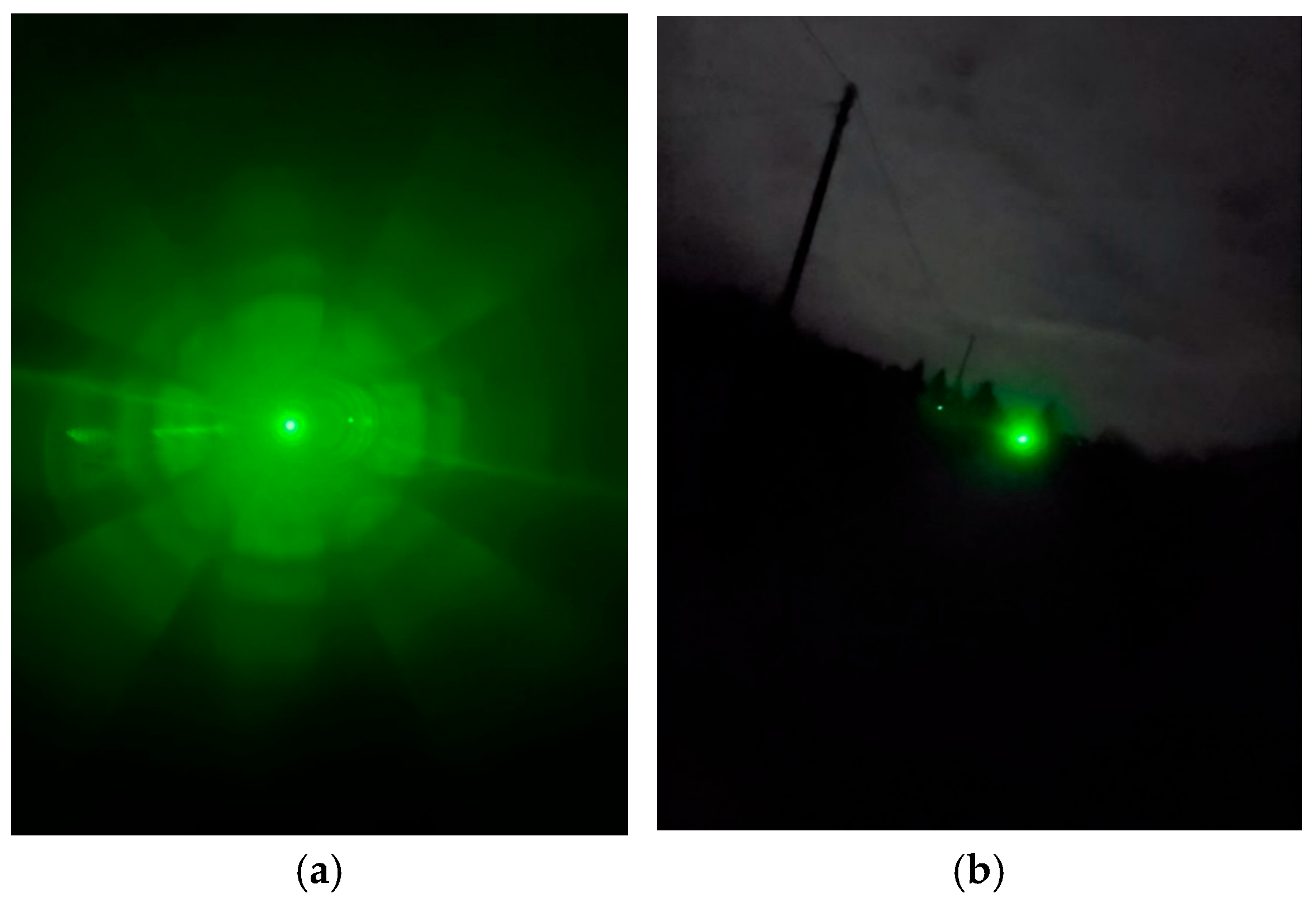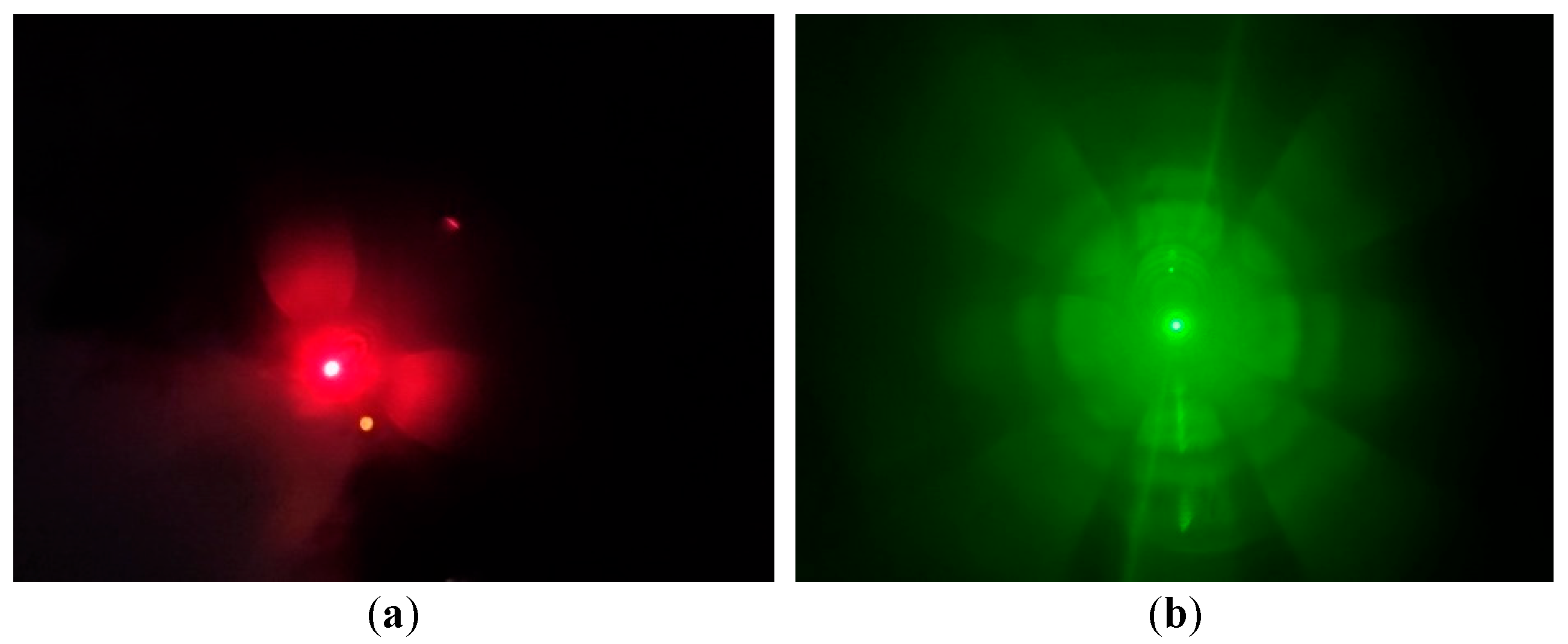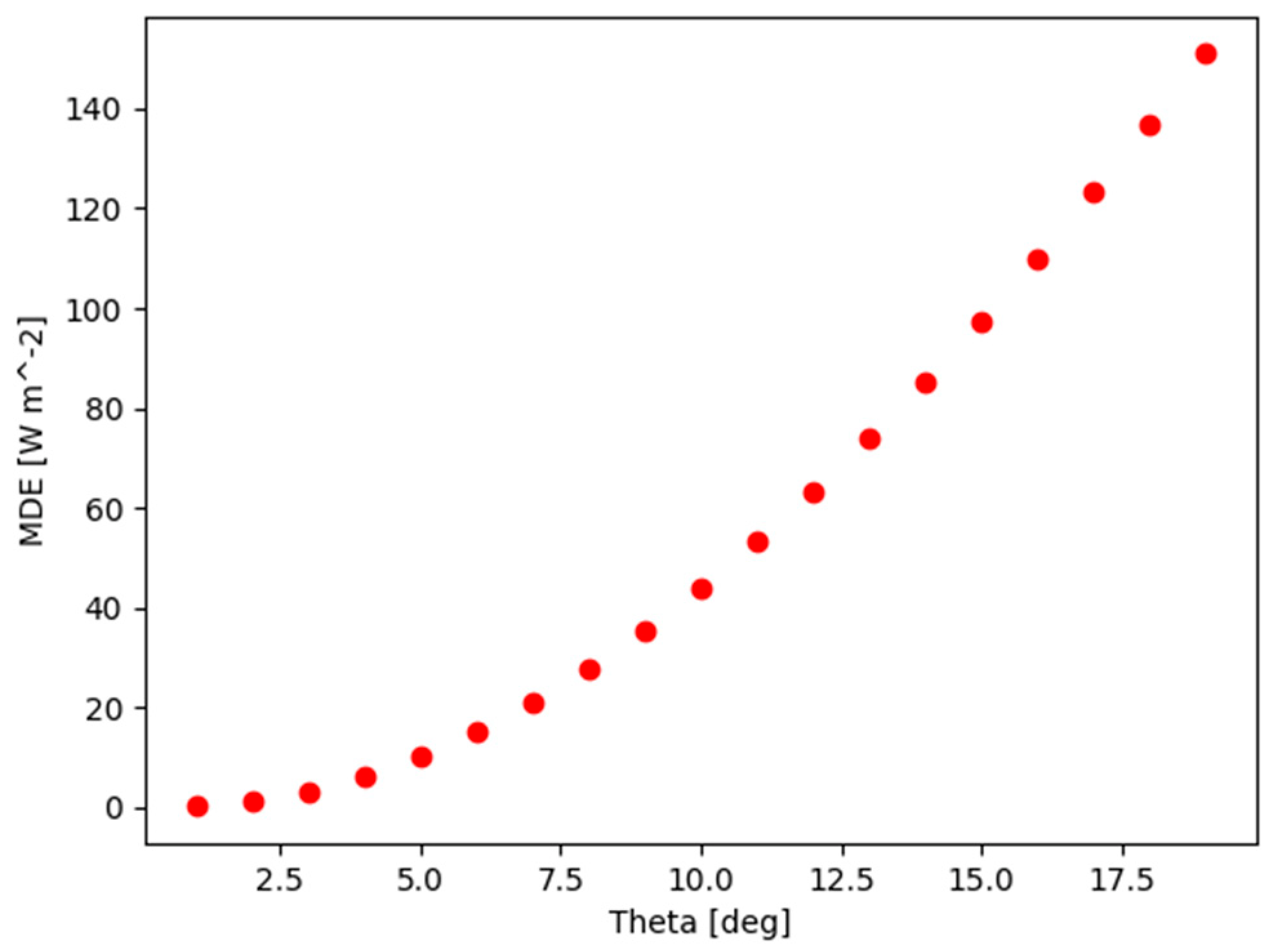1. Introduction
Although flight safety is constantly increased by new procedures, training and making pilots aware of the dangers in the air and at the airport, there is still a risk of aviation incidents or disasters [
1]. This happens because there are dangers that do not arise from the poor preparation of pilots for air operations, but from the ignorance of people not associated with aviation. The motivation for this paper are the increasingly frequent incidents of pilots being dazzled by laser beams. Most people who “play” in this way do not realize the consequences of their actions. A Polish Air Rescue Doctor, who is recovering from retinal damage, has found out just how dangerous a laser pointed at a flying aeroplane or helicopter can be [
2]. Even if the laser does not cause direct injury, it may distract the pilot and consequently lead to an accident. The importance of the problem has also been noticed by the EASA (European Union Aviation Safety Agency) by qualification of the aircraft illumination by laser category mitigated for the years 2021–2025 [
3]. The authors of the report underline that laser effects may pose significant flight safety hazards in critical phases of flight during approach and landing near airports. In this flight phase the aircraft is at a low altitude, which increases the probability of even an accidental shot. This situation is particularly dangerous if laser shows are performed in the neighborhood of the approach path, especially concerts or festivals where the laser power can reach up to 5000 mW [
4]. Therefore, special safety rules should be respected when using lasers, either professional or amateur, especially if it might affect the safety of a transport system or endanger others.
One such danger is dazzling pilots and, as a consequence, the loss of control over aircraft. The trend of this problem is increasing all over the world. In most cases, the perpetrators are unaware of their actions. The consequences of such actions can be tragic from dazzling and distracting the pilot’s attention to even eye damage. There are no commonly used laser beam safeguards in aviation, for example, protective goggles, although their cost is similar to the cost of good sunglasses. Due to the lack of good protection, engineers are working on material that can protect the aircraft crew against lasers [
5,
6,
7].
The main contributions of this paper can be summarized as follows:
Showing that even as the energy of lasers increases, the likelihood of eye harm increases, but still eye harm from lasers commonly is unlikely, the bigger problem is pilot dazzling;
To propose, carry out, and describe the results of an experiment allowing the passage of light through the windscreen to be measured in a simple way;
The use of in-service aircraft in the experiment;
As a prevention solution, an example of demarcation of an area where laser use should be prohibited due to the possibility of dazzling the pilot.
The paper is structured as follows: In the theoretical part, a mathematical model of light intensity fading with distance from its source is provided, whereas in the experimental part the measurement of light intensity as a function of varying distance is demonstrated. The presented results are summarized with a statement that such measurements allow determining zones around the airport where lasers should be prohibited. Additionally, the results show that even if the laser does not cause direct injury, it may distract the crew and consequently lead to an accident.
2. Research Background
2.1. Safety in Aviation
Safety in air transport is understood as the property of a system to operate under given environmental conditions without accidents and unexpected actions [
8,
9]. A few years ago, the aircraft’s safety was strictly related to the behavior of people associated with aviation [
10]. Just as the aviation system is complex and interrelated, so is aviation safety. Aviation safety involves designing aircraft and airports, training ground personnel [
11] and flight crew members, maintenance of aircraft [
12], airfields, en route and terminal area navigation and communication facilities defining and implementing air traffic control procedures of the Federal Aviation Regulations (FARs) [
13], and much more [
14,
15]. In addition, it is important to be aware that in addition to the factors mentioned above, the environment, such as people playing with a laser, plays an important role.
The study of the safety status of systems can most generally be reduced to an analysis of factors such as [
16]:
The risk of security threats that arise in the transport system and its environment;
The possibility of counteracting the existing threats and their effects by external rescue systems;
Mutual relations between the security threat and the effectiveness of counteracting and mitigating the effects of the events that occur.
It should also be mentioned that the human and organizational factors play significant roles in the occurrence of civil aviation accidents and incidents. Many statistical studies have proved that human errors led to 70–80% of civil and military aviation accidents [
17,
18,
19].
2.2. Laser Incidents in Aviation
Laser attacks on aircraft have been on record since the mid 1990s, however, official reporting of laser incidents really only began in the mid 2000s [
19]. Fortunately, instances of laser eye damage caused by incidental contact are rare. There were no significant or permanent eye injuries due to exposure to lasers. Temporary symptoms have been observed in both red (650 nm) and green (532 nm) laser pointer exposures, but these cases have always been in cases of intentional, direct ocular, overexposure (10 s–15 min) and have healed in 10 weeks [
20]. In other incidents outdoor lasers have illuminated commercial air carrier crews. In two specific cases, an October 30 1995 incident involving a Southwest Airlines plane departing McCarran Airport in Las Vegas, and a 29 November 1996 incident of a Skywest aircraft arriving at Los Angeles International Airport, the pilot of the aircraft experienced symptoms so severe that control of the aircraft was transferred to the copilot [
21].
A UK data report showed that about 2300 cases of laser pointer light exposure were reported in 2011. None of these cases were associated with significant ocular injury or an aviation mishap. The Federal Aviation Administration (FAA) reported 5352 exposures in 2015 [
22].
In the other publication [
23], the case when an airline pilot was complaining of a dazzle spot in the upper left area of his visual field in the right eye following exposure to a blue laser beam during the landing is described. At an altitude of approximately 396 m, his right eye was hit by a blue laser and he noticed immediate flash dazzles and pain. During an eye coherence tomography scan, a lesion was observed in the eye, specifically a retinal lesion that looked like a laser burn.
The number as well as the consequences of the aircraft illuminated with laser pointers had been described by Nakagawara and Montgomery [
24]. In their report, the cases from January 1996 to July 1999 in the west-Pacific FAA Region have been studied. They identified more than 150 incidents in which low-flying aircraft were illuminated by lasers. Laser pointers were used in the majority of these incidents, and there were several occurrences of visual impairment to the pilot. Representative examples of documented reports are presented that involve the illumination of civilian flight crewmembers using these handheld devices [
25]. The authors concluded that laser pointers have caused ocular injury and may compromise aviation safety when used to illuminate aircraft in critical phases of flight. The proper selection and use of these devices can minimize the threat of temporary incapacitation and eye injury [
26].
2.3. Statistics of Laser Dazzling of Aircraft Pilots
Temporary impairment of human performance caused by visible wavelength laser light can increasingly be observed in both civilian and military flights. This is due to the intentional targeting of aircraft by high-powered lasers, which can cause visual disturbances for pilots at long distances [
27]. Since 2010, the number of reported laser events in the USA has increased 148% [
28]. The American statistics reported by the FAA [
28] are summarized in
Table 1. It can be noticed from the
Table 1 that in recent years there has been an increase in the number of cases of aircraft being illuminated with higher power lasers. The lack of cases with eye damage in the years 2010–2014 may also be due to changes in the reporting of such cases, unfortunately this information is not available in official statistics. It can also be noticed that the number of eye injuries is generally higher when the eye is exposed to a more energetic green or blue laser than in the case of a red laser, for which the eye hazard distance is shorter [
29].
The Polish statistics of laser dazzling of aircraft pilots are 524 cases from 2009 to 2015. In 2009—12 cases; 2010—36 cases; in 2011—57; in 2012—89; in 2013—90; in 2014—130; in 2015—110. After the confirmed case of temporary green laser dazzling of the pilot. all cases are now treated as incidents (Polish Register of Military Aviation Authorities) [
30].
The differences in rate of incidents for Poland is most likely related to two factors: the reporting method, because in the USA there is a special system set up for reporting of incidents by pilots as well as a significantly lower number of flights on Polish territory.
Number of laser incidents normalized to the number of flights is presented in
Figure 1. It can be observed that the trend is similar for the USA and Poland.
Despite the marginal number of pilot injuries from laser illumination, the importance of the problem has been recognized by the ICAO (International Civil Aviation Organization), which has published a document on how a pilot should behave during a laser attack [
31].
2.4. Factors Affecting Lasers in Aviation
The main factors that can affect lasers in aviation [
32] are as follows:
Weather: clouds inhibit laser beams.
Time of day: the eyes adapt to the darkness separately, and it may take up to 30 min. When the adapted eye is hit by light, it loses its adaptation and, in turn, it takes several seconds for the eye to adapt to bright light. During this adaptation phase, vision is distracted. This is why the problems with lasers occur mainly during darkness [
33].
The power of the laser: the more powerful the laser the more distraction and damage it can cause.
Color of the laser beam: the retina is most sensitive to green light wavelengths.
Distance and relative angle of the laser and aircraft: the closer the laser is to the aircraft the more powerful it is and the lower the relative angle of the beam the more dangerous it is (a laser beam from straight ahead is the worst case).
Speed of the aircraft: the higher the aircraft’s speed, the more difficult it is for the perpetrator to hit the aircraft, reducing the exposure risk.
Exposure time: the longer the exposure time, the more dangerous it is. Fortunately, the aircraft speed and the fact that most of the laser pointers are handheld will reduce the exposure time.
2.5. Laser Damage to Eyesight
The laser device generates a light beam, which, unlike ordinary light, is monochrome, unidirectional, coherent, and minimally divergent [
34]. The consequence of this is that such a device can focus most of its radiation power on very small areas, even at considerable distances. The radiation of near-infrared and visible light in the electromagnetic spectrum is focused by the refractive media of the eye on an image of a retina with a diameter of approximately 5–30 μm [
35]. This focus increases the intensity of retinal irradiation by a factor greater than 10,000 above the allowable irradiation of the cornea. Since no other organ of the human body concentrates light radiation, so intensely, the retina is the tissue the least resistant to laser damage. Another consequence of this point in energy accumulation is that even small amounts of energy generated by relatively low power laser devices can negatively affect the retina [
36]. Such lasers are commonly used in the army and laboratories and emit energy in the order of tens of μJ for pulsating lasers or hundreds of μW for continuous wave lasers. Since high powered lasers are rarely used in these instances injuries are uncommon [
37]. A similar conclusion can be deduced from
Table 1. In the period 2015–2021, under 1% of all laser glares resulted in eye damage. However, if the laser power is high enough, the nerve fiber layer could be damaged. This could result in a scotomoa, a blind spot or partial loss of sight [
38].
The susceptibility to damage may depend on the pupil diameter and pigmentation of the retina [
23]. If the pupils are dilated, then more energy falls on the cornea of the eye, so the damage caused by the laser occurring at night or in other dark conditions will be greater than in daylight. The more pigmented the retina and choroid of the eye, the more energy they absorb [
39].
Interestingly, the refractive state of the eye at the time of laser damage will reduce the extend of eye damage, because in the case of entropy, the beam will gather in front of or behind the retina and will spread over the larger “blur circle” of the retina. The energy density that hits the spot will drop. A 1 diopter reduction of eye diopter power leads to a 10-fold increase in the size of the retinal spot, while irradiance decreases by two orders of magnitude [
40].
It is impossible to investigate the effect of laser light on damage to the human eye during laser illumination of aircraft, because of the risks involved. Therefore, a camera reflecting the functioning of the human eye could be a solution during such tests. This idea has been proposed by Korber and Eberle [
41]. The authors presented the efforts of designing and planning their human eye camera but the prototype is still not completed.
2.6. Laser Eye Dazzle
Last but not least, it should be mentioned that the laser light propagation has been described in many valuable journals and articles. It is not possible to mention all of them, but some important aspects described in them should be noted. Some of them were specially dedicated to the investigation of the behavior of laser light passing through the windscreen. One of them is the work of Korber et al. [
42], in which the authors describe the assessment of dazzle effects originating from light scattering at an aircraft windscreen by comparing the images of two cameras: one outside and one inside the canopy. The general findings showed that the canopy, which had been used previously on an aircraft, substantially affected the dazzle pattern in the camera within the canopy as compared to the camera outside.
The study investigates the extent to which the windscreen affects the severity of laser eye dazzle experienced by the human eye, which has also been examined by Williamson et al. [
43]. In contrary to the experiment presented in this paper, they concentrated on the measurements of windscreen scatter.
A simple model of laser eye glare together with calculations for laser safety applications based on newly defined maximum glare exposure (MDE) and nominal eye glare distance (NODD) values are presented in [
44]. In this study, an intraocular scattering model was combined with a contrast threshold detection model to quantify the effects of laser glare on human functioning.
Analogous enabling studies as for the eye dazzle effect were conducted for camera sensors [
45].
Summarizing, the impact of laser light on both flight safety as well as on the health of the vehicle operator is widely investigated. Research is unfortunately hampered by the impossibility of performing tests under real conditions.
3. Methods
3.1. Mathematical Model
When describing lighting intensity and light intensity, a luminous flux was used. It refers to the power emitted from a given light source that can create a visual impression in the eye of the observer. The energy stream, unlike light, contains the radiation power outside the visible range of the eye. The luminous flux can be described by the Equation (1).
where:
Φv—luminous flux;
Km—photometric radiation equivalent;
Φe—energy stream;
V(λ)—photopic spectral luminous efficiency curve;
λ—wavelength.
The photopic spectral light efficiency curve was adopted by the Lighting Committee in 1924 and is valid today. The maximum curve value is for a wavelength equal to 555 nm. For this value, the human eye is the most sensitive
The variation in the beam diameter in the beam waist region can be defined by equation [
46]:
where:
—the beam waist;
z—distance from the laser to the aircraft.
The illuminance depends on the luminous intensity, the distance of the surface from the light source, and the angle between the normal to the illuminated surface and the direction of light propagation:
where:
E—illuminance (lx);
I—luminous flux of light source (cd);
r—distance of the light source from the surface (m);
α—angle between normal and the direction of the luminous intensity (rad).
The measured illuminance can be used to determine the “CIE General Disability Glare Equation” [
47]:
where:
θ—the angle between the glare source and the line of sight (0.1° < θ < 100°);
A—the age of the individuals (for example, the pilot);
p—an eye pigmentation factor (p = 0 for black, 0.5 for brown, 1.0 for light, 1.2 for very light eyes).
In [
48], the authors indicated that this equation overestimates laser eye dazzle and in [
44] two calibration factors,
S1 and
T1, were proposed; once applied, Equation (4) becomes:
where:
—background luminance ();
—calibration factors 0.9239 and 0.6795, respectively.
3.2. Experimental Setup
Two experimental systems were used to carry out the measurements. The first system consisted of a laser attached to a tripod, DA-20 windscreen, and a lux meter or camera (
Figure 2). The laser was positioned to ensure that the beam passing through into the cockpit of the aircraft was constant (see
Figure 3a). The same steps were taken for the lux meter to set its position and ensure that the laser beam was perpendicular to the measuring surface (see
Figure 3b). The lux meter was positioned behind the windscreen at the pilot’s head height. The laser was placed in the front of the windscreen and focused on the lux meter. Due to the experiment’s configuration, the lux meter only measured the light scattered by the windscreen. The measurement was performed every 20 m, because it was the maximum allowed distance from the tape.
For technical reasons, not the aircraft but the windscreen itself was used for the night measurements. The second (night) system consisted of a laser attached to a tripod, a piece of acrylic thermoplastic (windscreen), glasses, and the lux meter. Unlike the first system, the laser beam had to be positioned only along a straight road and did not have to hit a specific place in the cockpit.
The laser parameters are summarized in
Table 2.
The lux meter L-50 [
49] was used to measure the illumination of the laser beam. The selected lux meter did not required additional corrections. Due to the very good adaptation of the detector spectral characteristics of the spectral distribution of the eye sensitivity for photopic vision, it was not necessary to use color correction factors to calculate the actual luminance value for radiation sources other than incandescent light sources. The photometric camera was equipped with a very good angular correction system, matching the directional characteristics to the cosine curve.
The DA-20 aircraft was used for the research. It is one of the basic aircraft used by the Academic Aviation Training Center in Deblin, Poland. It is a two-seater aircraft with a four-cylinder piston engine. The fuselage has a half-shell composite structure. However, the most important part is the fairing. It is made of acrylic glass and has a thickness of 4 mm. The angle at which it is profiled in individual places was not provided by the manufacturer.
4. Data Collection
Configuration of the Experiment
The collected data can be divided according to the color of the laser and the time of day/night when the measurements were taken. The following sets of data can be distinguished:
Setup 1—red laser/day;
Setup 2—green laser/day;
Setup 3—red laser/night;
Setup 4—green laser/night.
The equipment used in Setup 1 and Setup 2 made it impossible to perform tests in the dark conditions. In this way the values were read from the lux meter consisting of sun rays and a laser beam. The device calibration was required before each measurement, which could generate additional measurement error. The sun’s rays differed in the cabin, which is why even the minimal head movements changed the value on the lux meter. Calibration values were recorded before the measurement when the photometric camera was placed at the height of the pilot’s head. The camera was then placed in the laser beam, which was not always at the same height as the average height of the pilot’s head.
However, the tested system reflects the real situation when the aircraft is in the take-off or alignment phase. This also shows a real situation where the pilot is temporarily blinded with a laser beam. The perception of a laser beam affects the distribution of attention on on-board instruments. The use of aircraft for testing eliminates problems associated with the reflection of the fairest of the aircraft.
5. Results
5.1. Setup 1—Red Laser during the Day
METAR reported a total cloudy sky with a cloud base of 300 ft at Deblin Airport on the measurement day. The air temperature was 1 °C. The experiments were carried out in November.
The intensity of illumination falling on the head should decrease when the distance increases (3). As the distance increased, the beam widened and only part of it fell on the head, hence, it cannot be assumed that the light is constant. However, assuming that as the distance increases, the light decreases linearly and the light intensity is inversely proportional to the square of the distance, it can be concluded that the chart should take the shape of a hyperbola. Only four measurements were carried out due to the low power of the red laser (
Figure 4). It was because after 80 m, the red laser was not visible in the cockpit.
Two types of models are presented in the
Figure 3, one which both constant
a and power are fitted, allowing the determination of whether the shape obtained is consistent with Equation (3). For the case under consideration, the obtained value of k agrees with the theoretical value within the error. The second model is a distribution with a fixed coefficient. In the case of Setup 1, no significant differences were observed.
Additionally, it should be mentioned that the calibration value for all measurements varied between 1.1 and 1.2 klx, which agrees with daylight values on a cloudy day.
5.2. Setup 2—Green Laser during the Day
Tests for the second laser were carried out on a different day than for the red laser. METAR for the Deblin Airport on the measurement day reported cloudiness 37. 5 ÷ 50% at 2000 ft and 62. 5 ÷ 87. 5% at 20,000 ft. The air temperature was 5 °C.
Due to measurement errors related to changing light intensity of sunlight, there was difficulty in setting the lux meter with the laser beam at right angles and hitting various parts of the windscreen. It should be added that the sun light illuminance was changing from 0.94 klx to 5.5 lkx, and it was measured for every distance point. The equation of the trend line is . The trend line with a fixed coefficient was fitted below the measured data.
By analyzing
Figure 4 and
Figure 5, it can be concluded that it is practically impossible to hit the pilot’s eye with a red laser at such close distances. It took about 4 min to aim at the photometric head placed in the cockpit from a distance of 200 m. In addition, the plane did not move, and a tripod was used for accurate aiming. When the plane is moving, hitting the pilot’s eye may occur. However, the exposure time will last for milliseconds, which should not disturb the pilot’s work. In addition, the laser beam is not wide enough to cover the entire cockpit with its light at such short distances, which allows it to be avoided efficiently by moving the head. Comparing the values obtained from the measurements of the red laser and the green laser, it can be concluded that the green laser is more dangerous for the pilot due to the reason that it usually is more powerful than the red one and the human eye is more sensitive for the light wavelength 532 nm than for 650 nm.
5.3. Setup 3—Red Laser at Night
Before the measurement, the lux meter indicated 0 klx due to the new moon phase and the cloudy sky. The temperature was near 0 °C. Measurements were made up to 400 m.
Figure 6 shows the dependence of the luminance on the distance from the red laser at night. The equation of the trend line is
. It means that the intensity of the light source stream falling on the meter at the maximum distance decreased and agrees within the expected errors “−2”. Based on the results, there can be noticed a measurement error between the theoretical value and the obtained results. It can be assumed that this was due to the meter errors and the fact that the position of the windscreen and the meter were not fixed together.
5.4. Setup 4—Green Laser at Night
Measurements were carried out on the same night as for the red laser. The weather conditions did not change.
Figure 7 presents the dependence of the luminance on the distance of the green laser at night. The equation of the trend line is
. Measurements were performed at 1100 m. This means that the intensity of the light source stream falling on the meter at the maximum distance decreased by a significant amount. This means that the trend line created from the measurements is correct and the measurement values are well matched to it.
The results presented in the figures are summarized in
Table 3.
By analyzing the results of the measurements made, the light intensity value fades as expected. A great difficulty in measurements made during the day was the changing value of sunlight. The lack of sunlight during the measurements caused the luminance value to decrease almost inversely proportional to the square of the distance. This is due to the solid angle of the laser and the non-increasing surface area of the photometric head. It is not possible to draw the appropriate conclusions for the red beam, because the measurement was made up to 80 m during the day. During daytime measurements, the intensity of the light source stream did not decrease significantly because the whole beam illuminated the photometric camera even at the maximum distance. Hence, the exponent of the trend line is almost equal to −2. It can also be noticed that the coefficient of determination in night measurements was greater than in daytime for each laser.
The illuminance significantly varies depending on daily conditions. For example, at 20 m, the values for measurements taken at night are seven times higher than during the day. The difference decreases as the distance increases. At about 150 m, the values of measurements at night are twice as high as those taken during the day. This leads to the conclusion that the laser beam carries the greatest danger at night. Considering that the human eye is more sensitive to light at night, this may result in other visual sensations. More specifically, the green laser pointer in scotopic vision will affect the eye more than in photopic vision. However, in the case of the red laser pointer a beam with a wavelength of 650 nm will affect the eye more effectively during the day than at night. However, it is worth remembering that adaptation from night to day vision conditions takes a few seconds. Light rays irritate our eyes, but this feeling passes. However, this is not the case with the laser beam.
In addition, the illuminance reduction factor was measured for the green laser at night when sunglasses were placed between the windscreen and the lux meter. It was determined that the light, after additionally passing through the glasses, has an illuminance equal to 14% of the initial value.
5.5. Critical Illuminance Level
High-intensity light has an impact on human vision, especially in low ambient light conditions. Safety zones have therefore been adopted for laser lights for critical tasks (e.g., flying an aircraft). Such values are defined in the ANSI Standard Z136.6 as threshold laser exposure levels (W/cm2) for visual interference at dusk or night. For application to high-intensity broadband lights, the relevant measure is illuminance (lx). Threshold levels of laser irradiance relevant to various effects of visual interference can be converted to threshold levels of lasers. It should be noted that this conversion is based on the hypothesis that photopic vision applies. This is a reasonable assumption for pilots, as an aviator’s eyes are usually not completely adapted to seeing in the dark at night due to ambient lighting, such as illuminated cockpit gauges and ground lights.
Additionally, it can be concluded that the highest illuminance value from all conducted experiments was around 70 klx from 20 m at night, assuming the beam is aimed directly at the pilot’s eye. This value significantly exceeds the illuminance threshold for eye damage, which is 17 klx [
50]. It should be noted, however, that hitting a flying aircraft from 20 m is practically unrealistic. Nevertheless, after reviewing the values obtained during the measurements, flash blindness (illuminance threshold of 0.68 klx [
50]) is a very probable scenario.
It can also be noticed that when the distance is greater, it is harder to avoid laser light entering the cockpit. Although, the intensity of the luminous flux decreases with increasing distance and is not large enough to cause serious damage to the eye with a short exposure time. Despite the low probability of eye damage, a major problem is pilot glare, especially (as remarked by pilots) during landing.
5.6. Size of the Beam
The dimensions of the laser beam were not measured during the conducted experiment. However, given that the physical characteristics of the changing laser beam at a certain distance from the source are well known, its approximate dimensions can be estimated. For a Gaussian laser beam, the divergence angle is equal to wavelength divided by (spot radius times pi). For example, when the green light has a wavelength of 532 nm, the spot radius is 1 mm. The diameter of the beam at 2000 m is going to be 0.69 m. The example impression of sizes seen from the distances of 100 and 1100 m is presented in
Figure 8.
Although the distance increases, the beam width makes it easier to hit the cockpit of the plane, this task does not become simpler due to more difficult aiming. Minimal movement in each plane will move the laser beam a greater distance, depending on the distance of the laser pointer from the object (
Figure 9). However, due to the difficulty in aiming and retaining the beam, it will penetrate through the canopy of the aircraft in a pulsating manner without a specified period. This will cause an even greater distraction for the pilot.
Finally, it should be mentioned that even if, fortunately, eye damage is rare, the sight of the laser beam illuminating the cockpit can still disturb operations.
Figure 10 shows the visibility of the red beam from the distance of 400 m as well as the green one from the distance of 1110 m.
5.7. Contrast Reduction
The perception of light penetrating an aircraft windscreen depends on a wide range of factors that modify the apparent visual contrast. Factors include light scattering, reflections, and birefringence. In addition, the material used can be micro-damaged.
When the aircraft is illuminated by a laser, the pilot may experience a significant reduction in visual contrast due to obstructive glare. If the source were in front of the eyes, the pilot would perceive the source of the glare in his central field of vision, and the main source of contrast reduction will be light scattered internally in his eyes (disability glare). In a situation where the beam is directed to the side of the aircraft, accidental damage to the eye may occur after the laser beam enters between the eye and, for example, the goggle. A second possible scenario is that the front windscreen will shine, introducing a veil of light that will further reduce the visibility of objects both inside and outside the aircraft.
When an aircraft is illuminated by a laser beam, both the background radiation and the target increase in value by the veiling luminance, causing the Webber contrast standard to take the form:
One may notice that veiling glare causes a decrease in contrast with the factor Lb/(Lb + Lv).
5.8. Maximum Dazzle Exposure
Fundamental to the simplicity of calculating the effects of laser glare is the concept of Maximum Dazzle Exposure (MDE). Laser eye glare results in part of the visual field becoming obscured by the appearance of a “glare field”—a bright, saturated area of vision. The MDE is the intensity of laser radiation in the eye above which an object cannot be visually detected by this glare field. When the laser irradiance is higher than the MDE, the glare field prevents the observer from detecting the object, whereas when the irradiance is lower than the MDE, the observer is able to detect the object. The MDE is analogous to the established concept of maximum permissible exposure (MPE), which defines the limit of laser irradiance above which there is a risk of permanent eye damage [
27].
The value of MDE is strongly dependent on the eye scattered function [
44]:
which is the part of veiling luminance,
The dependence of MDE for scatter angle,
is presented in
Figure 11. The intended values in this analysis were below 2 degrees.
The authors of the manuscript [
27] point out one more very important aspect related to the determination of MDE values. They postulate that they should be scaled according to the laser wavelength considered, corresponding to the photopic sensitivity of the eye V(λ). The eye is less sensitive to blue (e.g., V(450 nm) = 0.0647) and red (e.g., V(650 nm) = 0.1193) wavelengths compared to green (e.g., V(532 nm) = 0.8783). In other words, the MDE values are expected to be higher for wavelengths with lower sensitivity, as higher irradiance is required to achieve the same effect. All MDE values in this case must then be divided by V(λ) for the laser wavelength to obtain the corresponding MDEs.
The values calculated in the conducted experiment, for example, for a green laser during the day, are in the range
. This means that the values are smaller than irradiance threshold level [
50].
6. Safety Improvements
Safety Procedures
As the results of the experiment demonstrated, the intensity of the laser light is so low that damage to the eye is unlikely, and the danger of the pilot being blinded. Therefore, during their training they are prepared for such incidents by showing material from such events and outlining guidelines for dealing with such situations. Above all, the pilot should not panic. In addition, when an airplane is illuminated by a laser, it is a standard procedure for pilots to alert Air Traffic Control (ATC) and for ATC to then broadcast warnings to other pilots in the area. This takes up valuable communication bandwidths, burdening the system, and potentially leading to miscommunications or airplane mis-haps [
51].
Subjective perceptions during laser glare measurements confirm that proper piloting of the aircraft in such situations can be hampered. This means danger for the entire flight crew and the passengers on board the aircraft. To effectively overcome the effects of the glare, the light flux through the pilot’s pupil must be reduced as quickly as possible. The simplest way to reduce it is to turn the head away from the source of the laser beam. However, this can be undertaken if the other pilot is not blinded and is able to operate the aircraft. In addition, turning the head away from the source of the laser beam should also be understood as starting to navigate according to the instruments, not directing the gaze towards the laser source.
In the absence of protective glasses, it is nevertheless advisable to wear sunglasses for safety reasons. It should be remembered that sunglasses with a UV filter are no substitute for protective glasses of the LGP type, which do not transmit light only of a given wavelength. This means that a pilot wearing LGP glasses, despite the higher protection (light transmission of a given wavelength is reduced to almost 0%), will see his surroundings better than with sunglasses. They can reduce the illumination. Furthermore, the majority of pilots, even novice pilots, carry such goggles in their aviation equipment. Reducing the sensation of glare is extremely important for a pilot to be able to continue a flying task safely. Pilot training is an extremely time-consuming process, especially for pilots of combat aircraft. In incidents involving laser glare, the pilot of the aircraft may suffer damage to his eyesight. This may exclude him from performing air operations for a certain period of time, or even prevent him from continuing to fly the aircraft in the case of vision loss. The problem of laser blindness of pilots should be taken seriously. Protective goggles should be provided in both military and civil aviation organizations.
7. Strengths and Limitations
Having a laser pointer targeted at an aircraft poses a serious safety risk to pilots, passengers, and those on the ground. Such laser attacks are illegal and can result in significant fines and even imprisonment. The strong point of this paper is the description of aircraft that are in daily operation for research. Additionally, it should be noted that this is a low-cost experiment but unfortunately was difficult to conduct due to restrictions on access to both an airport and aircraft. These factors make the experiment unique despite its simplicity. In our opinion, it is an advantage to conduct the experiment in conditions close to reality. It would be too dangerous to carry out the experiment under real conditions and could directly endanger the lives of the pilots. In parallel, we are aware of the low precision of the measurements. However, from the point of view of flight safety, this is not a deficiency. The experiment was undertaken to show with which intensity of laser light that pilots come into contact. Additionally, we revealed that the main threat to pilot health and precision of performing flight operations is being dazzled and not the radiation intensity.
As previously mentioned, our main limitation was the precision of the measurements. However, we intentionally did not build an experimental setup that would allow us to increase the precision of hitting the sensor with a laser. It would also be an interesting result to measure the intensity of laser light emitted from different angles and preferably to an aircraft located at a certain height, which could be a direction in which research should be extended in the future.
8. Conclusions
The study showed the problem of pilots being dazzled by a laser. This is especially important due to the growing number of events and the lack of implementation of preventive measures.
The measurements performed in the first system were not satisfactory, so it was decided to change systematically. This forced measurements at night to eliminate the effect of solar lighting.
Taking into consideration the light intensity during these illumination incidents, fortunately, the risk of permanent damage to the eye is very small; however, when the event occurs at low altitude it can be extremely dangerous because of the glare, flash blindness, and after images. It is important to furtherer elucidate how the effects of glare from laser can be minimized, either by behavioral responses or by protective filters or glasses.
This work and the results obtained can be used as educational material for adept pilots and experienced pilots. It shows ignorance of the dazzling perpetrators and easy access to laser pointers. Appropriate steps are needed to reduce the number of such incidents. This will result in increased flight safety, which is the most important during flight operations.
Taking into consideration that military pilots may have light-enhancing devices in their eyes, the likelihood of damaging the vision may be even greater. Additional research should be conducted not only on the intensity of the laser light with distance, but also on the pilot’s reaction to the glare and appropriate training on how to behave in such a situation.
The next phase of the study will be to measure luminosity as a function of scattering angle. In addition, more sensors should be installed to check how the laser light propagates through the cockpit. In contrast to the well-known models of laser light scattering, this research is still important due to the lack of knowledge of the exact structure and shape of the windscreen, the wide range of lasers (large energy range of lasers), the different angle, and distance of incidence.
9. Practical Applications
The possibility of determining the transition of laser light through the windscreen of the aircraft and its intensity under near real-life conditions, the ability to determine the passage of laser light through an aircraft windscreen, and its intensity under near real-world conditions will allow, in conjunction with laboratory measurements and computer simulations, to determine how different shapes and types of windscreens allow for increased safety of cabin occupants.
Author Contributions
W.W.: supervision of writing, discussion and control of correctness of results. M.Z.: conceptualization, methodology, investigation. M.M.: data acquisition, supervision of data analysis. J.T.: investigation, writing, review of current knowledge, editing. G.K.: original draft preparation, visualization, investigation. D.W.: writing—original draft preparation, data acquisition and analysis. All authors have read and agreed to the published version of the manuscript.
Funding
This research received no external funding.
Informed Consent Statement
Not applicable.
Acknowledgments
The authors would like to express their gratitude to the personnel of the 41st Training Air Base for providing the airport and aircraft for the experiment.
Conflicts of Interest
The authors declare no conflict of interest.
References
- Dwyer, T. Industrial safety engineering—Challenges of the future. Accid. Anal. Prev. 1992, 24, 265–273. [Google Scholar] [CrossRef]
- LPR Crew Blinded by Laser. Police: We Are Conducting Preliminary Operational Activities. Available online: https://tvn24.pl/tvnwarszawa/okolice/zaloga-lpr-oslepiona-laserem-pod-warszawa-ucierpial-ratownik-medyczny-1776244 (accessed on 7 February 2022). (In Polish).
- EASA. European Plan for Aviation Safety (EPAS) 2021–2025; Safety Risk Portfolios; EASA: Cologne, Germany, 2021.
- Szymański, M.; Kozłowska, A.; Tomm, J.; Huk, R.; Maląg, A.; Rusek, M. From Two- to Three-Dimensional Model of Heat Flow in Edge-Emitting Laser: Theory, Experiment and Numerical Tools. Energies 2021, 14, 7006. [Google Scholar] [CrossRef]
- Kallos, E.; Palikaras, G. Laser attacks against aircraft: Past, present and future. In Proceedings of the 2015 Photonics North, Ottawa, ON, Canada, 9–11 June 2015; p. 1. [Google Scholar]
- Schmid, D.; Stanton, N.A. How are laser attacks encountered in commercial aviation? A hazard analysis based on systems theory. Saf. Sci. 2018, 110, 178–191. [Google Scholar] [CrossRef]
- Xiong, Z.; Xu, H.; Li, W.; Cai, Z. Multi-Source Adversarial Sample Attack on Autonomous Vehicles. IEEE Trans. Veh. Technol. 2021, 70, 2822–2835. [Google Scholar] [CrossRef]
- Żurek, J. Review of the safety evaluation methods in aviation. Probl. Eksploat. 2009, 4, 61–70. [Google Scholar]
- Tomaszewska, J.; Zurek, J. Analysis of the equipment operation system in terms of availability. J. KONBiN 2017, 40, 5–20. [Google Scholar] [CrossRef]
- Zieja, M.; Smoliński, H.; Gołda, P. Management of the training process of military pilots based on the analysis and assessment of flight parameters from on-board recorders. J. KONBiN 2016, 40, 101–144. [Google Scholar] [CrossRef]
- Yang, Q.; Qiao, Z.; Yang, B.; Shi, Z. Modeling and uncovering the passenger-taxi dynamic queues at taxi station with multiple boarding points using a Markovian environment. Phys.-Stat. Mech. Its Appl. 2021, 572, 125870. [Google Scholar] [CrossRef]
- Noort, M.C.; Reader, T.W.; Gillespie, A. Safety voice and safety listening during aviation accidents: Cockpit voice recordings reveal that speaking-up to power is not enough. Saf. Sci. 2021, 139, 105260. [Google Scholar] [CrossRef]
- Saez, R.; Prats, X.; Polishchuk, T.; Polishchuk, V. Traffic synchronization in terminal airspace to enable continuous descent operations in trombone sequencing and merging procedures: An implementation study for Frankfurt airport. Transp. Res. Part C-Emerg. Technol. 2020, 121, 102875. [Google Scholar] [CrossRef]
- Ausrotas, R.; Jo, R.; Hansman, R. Aviation Safety Analysis; Massachusetts Institute of Technology: Cambridge, MA, USA, 2012. [Google Scholar]
- Naevestad, T.-O.; Bye, R.J.; Antonsen, S.; Berge, S.H.; Hesjevoll, I.S.; Elvebakk, B. Examining the most accident-prone sector within commercial aviation: Why do accidents with light inland helicopters occur, and how can we improve safety? Saf. Sci. 2021, 139, 105235. [Google Scholar] [CrossRef]
- Lofquist, E.A. The art of measuring nothing: The paradox of measuring safety in a changing civil aviation industry using traditional safety metrics. Saf. Sci. 2010, 48, 1520–1529. [Google Scholar] [CrossRef]
- Shappell, S.; Detwiler, C.; Holcomb, K.; Hackworth, C.; Boquet, A.; Wiegmann, D. Human Error and Commercial Aviation Accidents: A Comprehensive, Fine-Grained Analysis Using HFACS. Available online: https://www.semanticscholar.org/paper/Human-Error-and-Commercial-Aviation-Accidents%3A-A-Shappell-Detwiler/5e559d5df8e06aafbc42747b753df4bb4b100f62 (accessed on 25 February 2022).
- Berninger, D.J. Understanding the role of human error in aircraft accidents. Transp. Res. Rec. 1991, 1298, 33–42. [Google Scholar]
- Richards, D.; Carroll, J. Laser attacks on aircraft: Shining the light on public attitude. In Proceedings of the AIAA Aviation and Aeronautics Forum and Exposition 2018, Atlanta, GA, USA, 25–29 June 2018. [Google Scholar]
- Hue, J.; Pelle, C.; Garrec, P.; Lartigue, O.; Baume, F.; Rochas, J. Laser damage tests and optical densities of laser goggles. In Proceedings of the Laser-Induced Damage in Optical Materials, Boulder, CO, USA, 4–7 October 1999; International Society for Optics and Photonics: Bellingham, WA, USA, 2000; Volume 3902, pp. 500–511. [Google Scholar]
- McLin, L.N.; Keppler, K.S. Examination of Laser Levels Associated with Flight Hazards; Laser Inst America: Orlando, FL, USA, 1997; pp. 447–456. ISBN 978-0-912035-13-0. [Google Scholar]
- Ajudua, S.; Mello, M. Shedding some light on laser pointer eye injuries. Pediatr. Emerg. Care 2007, 23, 669–672. [Google Scholar] [CrossRef] [PubMed]
- Gosling, D.B.; O’Hagan, J.B.; Quhill, F.M. Blue Laser Induced Retinal Injury in a Commercial Pilot at 1300 ft. Aerosp. Med. Hum. Perform. 2016, 87, 69–70. [Google Scholar] [CrossRef] [PubMed]
- Nakagawara, V.; Montgomery, R.W. Laser pointers and aviation safety. Aviat. Space Environ. Med. 2000, 71, 1060–1062. [Google Scholar]
- Nakagawara, V.B.; Wood, K.J.; Mongomery, R.W. A Review of Recent Laser Illumination Events in the Aviation Environment; Federal Aviation Administration: Oklahoma City, OK, USA; Civil Aeromedical Institute: Oklahoma City, OK, USA, 2006.
- Nakagawara, V.; Montgomery, R. Laser Pointers: Their Potential Affects on Vision and Aviation Safety; U.S. Department of Transportation: Washington, DC, USA, 2001; p. 10.
- Williamson, C.A.; McLin, L.N. Determination of a laser eye dazzle safety framework. J. Laser Appl. 2018, 30, 32010. [Google Scholar] [CrossRef]
- FAA. Laser Incidents. Available online: https://www.faa.gov/about/initiatives/lasers/laws/ (accessed on 21 October 2021).
- Leccese, F.; Vandelanotte, V.; Salvadori, G.; Rocca, M. Blue Light Hazard and Risk Group Classification of 8 W LED Tubes, Replacing Fluorescent Tubes, through Optical Radiation Measurements. Sustainability 2015, 7, 13454–13468. [Google Scholar] [CrossRef]
- ULC. National Security Plan 2017–2020; Civil Aviation Authority: Warsaw, Poland, 2017. (In Polish) [Google Scholar]
- ICAO. LASER Attacks Safety Guidelines 2017; ICAO: Montreal, QC, Canada, 2017. [Google Scholar]
- The Effects of Laser Illumination of Aircraft. The Global Voice of Pilots. 2009. Available online: https://www.ifalpa.org/media/2053/12medbl01-the-effects-of-laser-illumination-of-aircraft.pdf (accessed on 21 October 2021).
- Sławiński, G.; Malesa, P.; Świerczewski, M. Analysis Regarding the Risk of Injuries of Soldiers Inside a Vehicle during Accidents Caused by Improvised Explosive Devices. Appl. Sci. 2019, 9, 4077. [Google Scholar] [CrossRef]
- Antończak, A.; Sotor, J.; Abramski, K. Single-frequency microchip solid state diode pumped lasers. Bull. Pol. Acad. Sci. Tech. Sci. 2008, 56, 113–116. [Google Scholar]
- Belkin, M. Ophthalmic manifestations of laser-induced eye injuries. In Laser-Inflicted Eye Injuries: Epidemiology, Prevention, and Treatment; International Society for Optics and Photonics: San Jose, CA, USA, 29–30 January 1996; Volume 2674, pp. 2–6. [Google Scholar]
- Elsner, A.; Muller, M. Laser applications and system considerations in ocular imaging. Laser Photonics Rev. 2008, 2, 350–376. [Google Scholar] [CrossRef] [PubMed]
- Birtel, J.; Harmening, W.M.; Krohne, T.U.; Holz, F.G.; Issa, P.C.; Herrmann, P. Retinal Injury Following Laser Pointer Exposure. Dtsch. Ärztebl. Int. 2017, 114, 831–837. [Google Scholar] [CrossRef] [PubMed]
- Zuclich, J.; Elliott, R.; Coffey, D. Suprathreshold retinal lesions induced by laser radiation. Lasers Light Ophthalmol. 1992, 5, 51–51. [Google Scholar]
- Kearney, J.; Cohen, H.; Stuck, B.; Rudd, G.; Beresky, D.; Wertz, F. Laser injury to multiple retinal foci. Lasers Surg. Med. 1987, 7, 499–502. [Google Scholar] [CrossRef]
- Stuck, B.; Belkin, M. Laser-inflicted eye injuries: Epidemiology, prevention, and treatment. In Proceedings of the SPIE—The International Society for Optical Engineering, San Jose, CA, USA, 29–30 January 1996; SPIE: Bellingham, WA, USA, 1996; Volume 2674. [Google Scholar]
- Koerber, M.; Eberle, B. Concept of a Human Eye Camera to Assess Laser Dazzling Interaction; Titterton, D.H., Grasso, R.J., Richardson, M.A., Eds.; SPIE: Edinburgh, UK, 2016; p. 99890M. [Google Scholar]
- Eberle, B.; Kinerk, W.T.; Koerber, M.; Öhgren, J.; Ritt, G.; Santos, C.N.; Schwarz, B.; Steinvall, O.; Tipper, S.M.; Vandewal, M.; et al. NATO SET-249 joint measurement campaign on laser dazzle effects in airborne scenarios. In Proceedings of the Technologies for Optical Countermeasures XVI, Strasbourg, France, 10–11 September 2019; Titterton, D.H., Grasso, R.J., Richardson, M.A., Eds.; SPIE: Strasbourg, France, 2019; p. 11. [Google Scholar]
- Williamson, C.A.; McLin, L.N.; Manka, M.A.; Rickman, J.M.; Garcia, P.V.; Smith, P.A. Impact of windscreen scatter on laser eye dazzle. Opt. Express 2018, 26, 27033–27057. [Google Scholar] [CrossRef]
- Williamson, C.A.; McLin, L.N. Nominal ocular dazzle distance (NODD). Appl. Opt. 2015, 54, 1564–1572. [Google Scholar] [CrossRef]
- Ritt, G. Correction: Ritt, G. Laser Safety Calculations for Imaging Sensors. Sensors 2019, 19, 3765. Sensors 2021, 21, 1959. [Google Scholar] [CrossRef]
- Edmund Optics Gaussian Beam Propagation. Available online: https://www.edmundoptics.com/knowledge-center/application-notes/lasers/gaussian-beam-propagation/ (accessed on 17 February 2022).
- Vos, J.; Cole, B.; Bodmann, H.; Elisa, C.; Takeuchi, T.; Berg, T. CIE equations for disability glare. CIE Collect. 2002, 135, 1–9. [Google Scholar]
- Mclin, L.; Smith, P.; Barnes, L.; Dykes, J.; Kuyk, T.; Novar, B.; Garcia, P.; Williamson, C. Scaling laser disability glare functions with “K” factors to predict dazzle. In Proceedings of the International Laser Safety Conference 2013, Orlando, FL, USA, 18–21 March 2013; pp. 278–287. [Google Scholar]
- L-50 Luxmeter. Available online: https://www.sonopan.com.pl/en/products/light/illuminance-meter-l-50-51/ (accessed on 16 June 2021).
- Toet, A.; Alferdinck, J. Effects of high power illuminators on vision through windscreens and driving behavior. In Proceedings of the Optics/Photonics in Security and Defence, Dresden, Germany, 23–26 September 2013; SPIE: Bellingham, WA, USA, 2013. [Google Scholar]
- Moffett, L. Laser Pointers as a Threat to Aviation Safety: The Problem, Current Policies, and Proposed Solutions. Ky. J. Equine Agric. Nat. Resour. Law 2018, 11, 32. [Google Scholar]
| Publisher’s Note: MDPI stays neutral with regard to jurisdictional claims in published maps and institutional affiliations. |
© 2022 by the authors. Licensee MDPI, Basel, Switzerland. This article is an open access article distributed under the terms and conditions of the Creative Commons Attribution (CC BY) license (https://creativecommons.org/licenses/by/4.0/).
